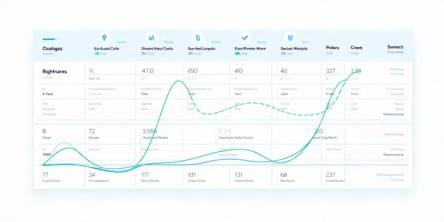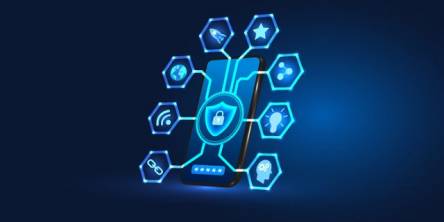How 5G Promises to Evolve AI Concepts?

The upcoming change in mobile networks, 5G, is under the pipeline. Users are awaiting the release of it as 5G promises a faster, better, and secure internet. The global digital population has reached the mark of 4.54 billion and still counting—the updates to the internet facility that 5G promises to bring better results and internet access to all. And the same affects the revolutions of AI concepts as well.
How Does 5G Work?
5G is the upcoming mobile broadband upgrade that will replace the 4G- LTE connections we currently use. It makes use of the mmWaves (Millimeter Waves) that help in delivering high-speed internet connection that can serve users with the best services.
5G network operates on three different spectrums that hold different specifications and have different functionalities as well. These three spectrums are:
Low-band Spectrum
The bandwidth of this spectrum is nearly depleted as it operates under 1GHz. The maximum speed a user can experience in this spectrum is 100mbps, and the coverage area is tremendous. It can easily penetrate through walls and remain accessible around large areas from the cell tower installed. LTE (4G) operates on the low-band spectrum in the U.S.
High-band Spectrum
The companies promising higher performance rates are depending on this trending technology to transfer the signals and provide data connectivity. However, the high-band spectrum has a very low penetration ability as it becomes weak while penetrating any physical objects. mmWaves fall under this spectrum.
Medium-band Spectrum
Medium-band spectrum provides faster connectivity and coverage area than high-band spectrum. However, the penetration capacity is much lowered compared to low-band spectrum. The maximum speed a signal can provide is up to 1 Gbps.
However, the performance guarantee in this spectrum is higher as it can deliver up to 10Gbps of signal strength and data connection speed to users. But the coverage area is very small, and the latency of signals is very low. But as it uses the high-band spectrum and broadband connectivity, no other users are present, and great speed of services is guaranteed for the users.
5G and AI: The Concept Evolution and Support
Artificial intelligence has become one of the most popular technology trends around the world. Because of the increasing popularity of these solutions, many businesses have found their way of delivering excellent user experiences. The implementation of modern concepts of AI supports the automation of mundane tasks and ensures businesses increase their revenues. And 5G is here to introduce an entirely new paradigm to all these applications.
1. IoT and AI Revolution Following the 5G Upgrade
The use of the internet in every new technology trend has become pretty obvious. Whether it is learning from the sensors, or collecting the user data, internet connectivity has become an essential part of all these processes. However, slower internet connections tend to slow down all the processes and wear up the devices faster.
But 5G will eliminate this situation. By serving users with high-speed internet connectivity, it will become easier to collect and process the user data that can generate efficient outputs. The slightly inaccurate outputs will no longer be produced as 5G will empower faster and easier processing and provide accurate data transfer.
For example, the sensors used in the IoT system wear out with time as the data connectivity needs are higher. But as 5G will get introduced, these sensors can generate and pass data at a greater pace than before and will deliver excellent outputs.
2. Empowers Robotics
Robotics has become one of the popular yet less explored fields of technology. The demand for resources and high-speed connectivity drives many developers away as it becomes impossible to meet the high-end resource requirements. However, the upcoming era of 5G will bring out the best approaches as it holds the power to shift robotics to new heights.
Intelligent robots will become the key phrase as 5G will get launched in the market. Higher file transfer rates, easier data connectivity, and availability of a wide variety of resources- including accurate data of millions of observations- hold power to make robotics one of the aspiring fields of the future.
As developers will find excellent support in delivering their best, robotics will explore new heights. The upcoming era will see significant development in this field where AI and machine learning will play extended roles in making these new systems smarter and better.
3. Remote Healthcare
Many of the primary AI implementations fall under the healthcare sector. As AI supports and emerges as a remote healthcare supporter, the solutions are not only automated but are high-speed to transact the data between the connected devices efficiently. The connection among these devices must be maintained strong and should be able to sustain large amounts of data transfers easily.
5G will introduce faster data transfer- it becomes easier to generate great results when data transfer rates are high. For example, when the GoJek clone app was introduced first in the market, users expected it to create responses as fast as it can- which led to enhanced functions and efficiency of the solution. Similarly, the remote healthcare sector deals with patient emergencies often and asks for faster transfer of data and information. And 5G can enable that.
4. Time-Dependant Industry Automation
Most of the industrial operations are time-critical. As businesses are focusing on automating the mundane tasks to generate accurate outputs, it becomes crucial for developers to keep the time constraint in mind. Also, the machine should be able to perform its best under every situation to become a profitable asset for a business.
As 5G is here to bring evolution in every AI concept, the same gets applied to these machines. Industrial automation demands accuracy and high-speed resources that can deliver as per the promises they do. While 5G is here to make the process of data exchange faster, it also holds the potential to revolutionize industrial automation with the best approaches and faster data transfer to support excellent communication.
Conclusion
As 5G is still under pipeline, there are many challenges to face before it gets launched in the market. Moreover, the plans released by Verizon, AT&T might sound a bit more expensive to many businesses and users alike. However, the support delivered through this broadband network upgrade promises better approaches. Until the primary limitation of this technology is not answered; we are using LTE and are comfortable with the services it provides.
But as 5G is about to be introduced, the ever-evolving concepts of AI will take off to reach new heights with the 5G support and excellent customer attention.
Similar Articles
Food delivery applications, including Uber Eats, DoorDash, Zomato, Swiggy, and Grubhub, generate large volumes of valuable data.
Modern businesses are drowning in communication overload, and much of that burden stems from outdated tools that simply can’t keep up
Building lending software isn’t just a technical project—it’s a business decision. Whether you're a fintech founder or part of a traditional lending institution trying to go digital, three questions will shape everything that follows
Learn why robust security is crucial for super app development. Explore key strategies and best practices for mobile app development security.
Walkie-talkies with an extensive reception capacity have changed significantly when it comes to portable communication by displaying cutting-edge features with seamless connectivity that covers more than just the state
USB-C technology has revolutionized the way we charge our devices, offering faster charging speeds, higher power delivery, and universal compatibility across multiple devices
Discover expert mobile app development strategies to create a viral app that attracts users and boosts engagement
Optimize app localization for iOS users across the EU with language, cultural, and regulatory adaptations. Engage users and boost retention with these tips!
Discover the top 10 mobile app development trends of 2024! Explore 5G, AI, AR/VR, blockchain, and more to stay ahead in the ever-evolving app development landscape.









